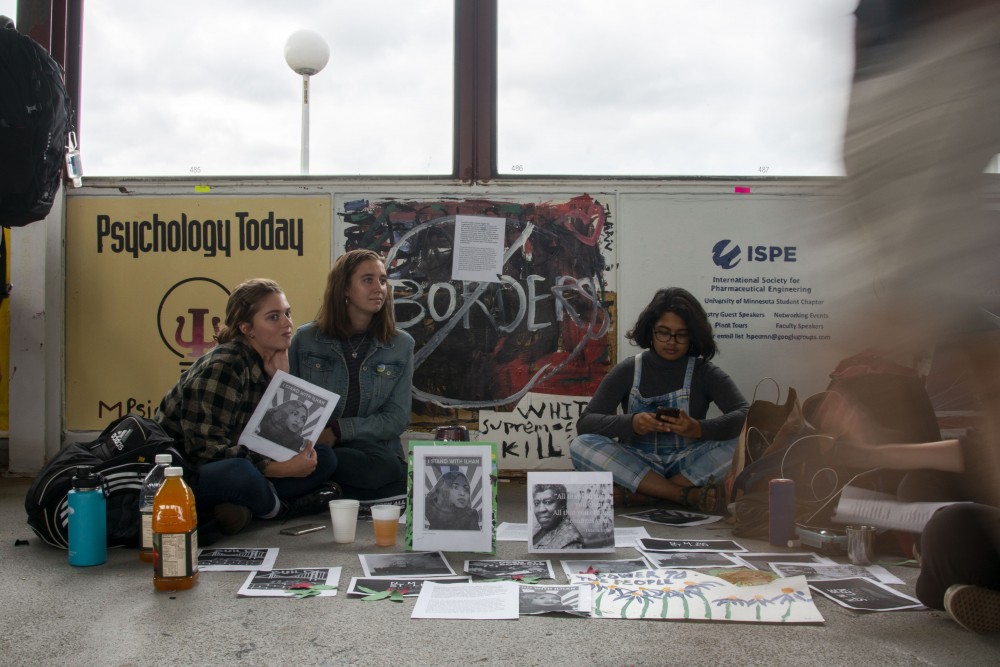The University of Minnesota’s chapter of College Republicans’ Paint the Bridge panel was spray-painted over on Friday, marking the fourth year in a row the group’s panel has been vandalized.
The panel was painted on Friday morning, depicting a brick wall which read “Donald Trump The Wall” below the words “Keep America Great.” The mural also appeared to depict the 9/11 terrorist attack next to a quote from Rep. Ilhan Omar, D-Minn., about the attack. On Friday evening, the mural was vandalized with the word “border” crossed out next to the words “White Supremacy Kills.”
The vandalism of the group’s panel has been an annual occurrence since President Donald Trump was elected in 2016, as all of their designs since have expressed support for his presidency.
Last year, the group’s panel was spray-painted after it criticized a University gender expression policy, saying “The proposed pronoun policy mocks real social issues.” In 2017, an altercation broke out and several conservative student groups’ panels were painted over after a joint panel between College Republicans and Turning Point USA claimed they were the “least popular minority on campus.” In 2016, the group’s panel sported the Trump slogan “Build the Wall,” which was vandalized and met by protests on the bridge.
Chase Christopherson, who was painting the College Republicans’ panel, explained the intention behind the painting, saying the wall design was inspired by a Pink Floyd album cover. Each brick represents one of President Donald Trump’s achievements, he said.
On Friday morning, Christopherson said he hopes the reaction from students will be to research Trump and come to a more positive conclusion about him.
Second-year Maddie Miller said the bricks on the painting, depicting Trump’s “successes” according to Christopherson, were from the perspective of those with privilege.
“It’s just looking at it from a white male perspective that is benefiting from all of this stuff,” Miller said. “It’s just really frustrating to see how close-minded it is especially considering this is a country we stole from Native peoples violently.”
University students Gayatri Narayanan and Nick Knighton, prior to the vandalization, sat next to the panel, holding posters of Omar, Christine Blasey Ford and Anita Hill. They held up messages related to missing Indigenous women and “open borders.”
Narayanan said she had a visceral reaction to the panel, and added posters around the painting in hopes of creating peace for others who feel the same as she did when she walked past.
“As a victim of sexual assault, to see Brett Kavanaugh’s name as an achievement on this panel … I have no words essentially. Your heart breaks inside when you see things like this,” Narayanan said.
Knighton said the type of rhetoric on the panel is a contributor to recent acts of white supremacy in the United States.
“I think the fact that that rhetoric that has give[n] rise to the white supremacists to come out and feel able to act and kill people is in part because of the normalization of that kind of culture and what’s written on this wall is helping normalize that,” he said.
In addition to their original panel, the College Republicans painted another panel on the bridge asking for readers to vandalize that panel instead of their main one, stating that vandalism was “inevitable.”
The topic of vandalism of the College Republicans’ past panels came up during a discussion of the campus climate at a July Board of Regents retreat. The discussion started by President Joan Gabel sharing what she called a concerning disparity between white and African American students when it comes to feeling a sense of belonging on campus.
The conversation quickly shifted, as some Regents shared they believe conservative students feel like they do not belong on a campus in a liberal city, citing previous vandalism and the University’s inability to figure out who was behind it.
When asked about the use of the phrase “safe space” on the panel, Christopherson of College Republicans emphasized that, to him, a safe space is a place where everyone can express their beliefs without being criticized or “shouted at … like I’ve been.”
Niamh Coomey, Samantha Hendrickson, Dylan Anderson and Max Chao contributed to this report.








